Photographs: Premshree Pillai/Wikimedia Commons Bibhu Ranjan Mishra and Praveen Bose in Bengaluru
There is a good chance that Bachubhai Patel's contribution to the security of the Indian skies will never be recorded.
A pity, considering his role in India's first light combat aircraft, the Tejas, which recently got its initial clearance.
The late Gujarati businessman, who ran a small outfit in Nashik that made automobile components, designed and developed a mission-critical micro-switch for the MiG fighter aircraft, used by the Indian Air Force at that time.
Till then, such micro-switches, which help engage and disengage the joystick from the autopilot, were bought from Russia, and the supply was undependable.
. . .
How light combat aircraft Tejas was made
Image: Water vapour builds up around a GE-powered aircraft as it breaks the sound barrier.Photographs: Reuters
Patel's switch was robust and capable of withstanding 10 million cycles of operation.
Kota Harinarayana, the man behind the Tejas, met Patel in 1981, four years before the Tejas was conceived. He mentioned the need to produce these switches indigenously to the businessman.
Patel asked for three months to make a prototype. What he made impressed Harinarayana. "When he brought us a sample of two switches, we found those to be of excellent quality. Patel had even bettered the switches the Russians were using."
In 1985, the defence ministry decided to build a light combat aircraft to replace the ageing MiGs. A sum of Rs 500 crore (Rs 5 billion) was set aside for it. (The final bill is Rs 3,248 crore, or Rs 32.48 billion.)
. . .
How light combat aircraft Tejas was made
Image: LCA Tejas.The project was given to the Aeronautical Development Agency, an arm of the Defence Research & Development Organisation, and Harinarayana, then 43, was put in charge.
What perhaps made him take up the challenge was the micro-switch Patel had shown him. Over the next 25 years, Harinarayana worked with 40 laboratories, 25 academic institutes and 300 companies to give shape to the Tejas.
On January 11 this year, it got initial operational clearance, and is now certain to be inducted into the Indian Air Force in two years.
Apart from the engine, almost 80 per cent of the aircraft's components have been designed and manufactured indigenously.
. . .
How light combat aircraft Tejas was made
Image: LCA Tejas.When Harinarayana started out in 1985, there simply wasn't enough aeronautical talent in DRDO. True, state-owned Hindustan Aeronautics Ltd (HAL) had built a fighter aircraft called the Marut in 1961 but it was designed by a German team (it remained in service till 1990).
Harinarayana, the first Indian to get a PhD in aircraft design, had to argue his case for a course in aeronautical engineering before IIT Bombay, his alma mater, saying "if MIT can, why not IIT?" He managed to rope in his research guides at IIT Bombay, GS Patel and TG Pai, to work on the project.
HAL had a design team of 200 to 300. HAL Chairman Air Marshal Malcolm Shirley Dundas Wollen agreed to send a few of his design engineers to ADA.
Another 40 to 50 people joined from organisations like National Aeronautics Laboratories and DRDO. Eighty to 100 people were recruited afresh.
. . .
How light combat aircraft Tejas was made
Image: LCA Tejas.In a year, ADA had a team of about 400 engineers and scientists. It also reached out to other institutes like the IITs and Jadhavpur University. "If we found a professor capable of doing something for us, we would catch him and give him work," says Harinarayana.
Now the team was in place but another problem cropped up -- it did not have the right computer for designing.
So Rajiv Gandhi, then prime minister, stepped in. During his visit to the United States soon after, he convinced President Ronald Reagan to give the IBM 390 computer for the design work of the Tejas.
ADA bought CATIA (computer-aided three-dimensional interactive application), the computer-aided design software developed by Dassault, in the early '90s.
. . .
How light combat aircraft Tejas was made
Image: GE chairman of the board and chief executive Jeffrey Immelt.Photographs: Reuters
Since the Tejas was meant to be a light aircraft, the designers had to use carbon composite materials which were still being developed. ADA then developed the software for designing and analysing composite materials, which it later marketed extensively -- Airbus was a customer, buying it for the A380 and other aircraft.
Infosys Technologies eventually took charge of marketing it.
The next step was to identify companies that could produce the components.
Furth India, a small Nagpur company, produced the steel. Another small outfit in Kanpur made rubber seals used to close the fuel tank.
. . .
How light combat aircraft Tejas was made
Image: LCA TejasGradually, ADA developed all the electrical components that were earlier imported and helped local companies manufacture them.
To make the production commercially viable, the rights to the intellectual property were handed over to the companies.
"We brought in an ecosystem in the country where the industry felt confident it could make a high-quality product. Laboratories became confident they could solve complex avionics problems. Academic institutions felt they could contribute significantly," says Harinarayana.
ADA knew the project was a humongous task for a small team. To avoid delays, the project was divided into 1,200 packages, each handed over to one person who would be responsible for its execution.
. . .
How light combat aircraft Tejas was made
Image: LCA TejasThe person responsible had to get his work done by any means -- he could partner industry, academia or research labs.
For example, instead of importing the multi-functional display for the cockpit, ADA approached Bharat Electronics to manufacture it. Though BEL was interested, it did not have adequate knowledge about the liquid crystal display (LCD) used in the product.
So ADA asked the Raman Research Institute, one of the pioneers in liquid crystals, to help out. The Tejas thus became a cementing force between industry and research institutes.
In 1993, ADA felt the aircraft may fly by 1999. But when the project was in the last lap, India conducted another nuclear test in 1998 which invited the ire and severe sanctions from the West.
. . .
How light combat aircraft Tejas was made
Image: Defence Minister A K Antony.General Electric, which had agreed to supply the engine, developed cold feet. Lockheed Martin, involved in the development of a "fly by wire" flight control system, too pulled back.
ADA was then forced to regroup its team of scientists and engineers to develop the entire software and hardware all over again.
It was only the recent thaw in Indo-US relations that made General Electric supply the engines for the Tejas. After that, it was smooth sailing for the aircraft.
The Tejas will cost Rs 180 crore to Rs 200 crore (Rs 1.80 billion to Rs 2 billion) apiece, though the trainer variant could cost up to Rs 220 crore (Rs 2.20 billion).
. . .
How light combat aircraft Tejas was made
Photographs: Courtesy, National Civil Aircraft Development.
The Indian Air Force has placed orders for 40 aircraft and is likely to buy another 100.
The success of the Tejas has encouraged the government to start work on a civilian aircraft and a regional transport aircraft.
A new body, National Civil Aircraft Programme, has been formed under Madhavan Nair, the former chairman of Indian Space Research Organisation. That's the real spinoff.
. . .

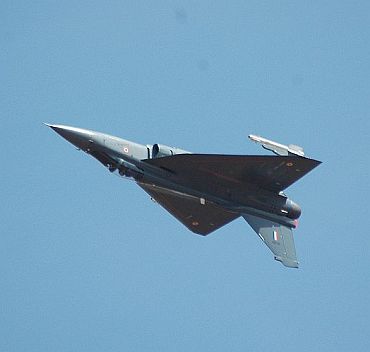
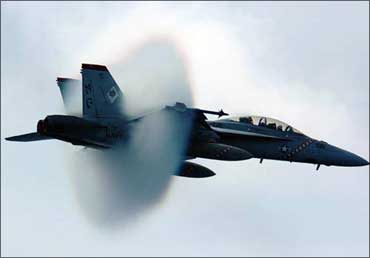
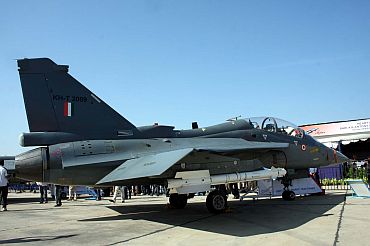
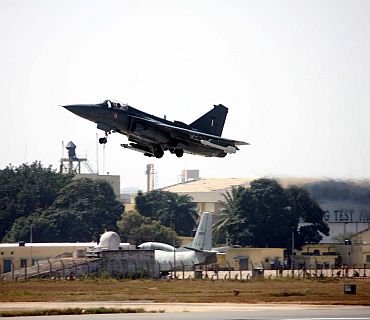
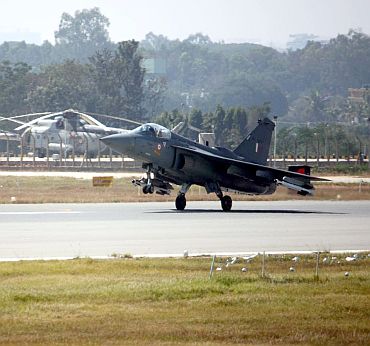

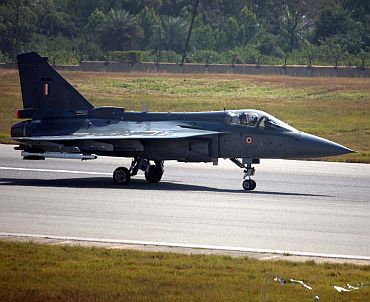
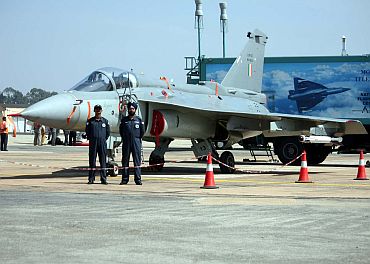
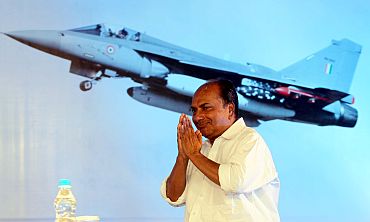


article